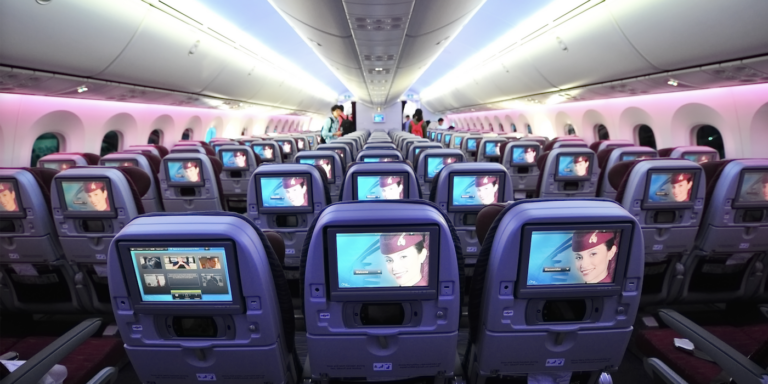The task of keeping cabin technology on a par with consumer technology is relentless. Smartphones and tablets are revolutionising the way passengers interact. Meanwhile, staple IFE equipment is enjoying its own revolution.
“Most of our end users have fantastic systems in their homes. They come to us and say ‘I want a 60in 3D LED screen just like the one in my home theatre’. There’s an expectation that the latest displays can be replicated on an aircraft easily, but you can’t just put a consumer display on an aircraft; few products at Best Buy are FAA- and EASA-certified!” says Jesse Swingle, who is responsible for marketing and media relations at Custom Control Concepts.
“Bulkhead and mounted displays need to be ruggedised to be aircraft qualified,” adds David Gray, president of Flight Display Systems. “DO-160 testing and aircraft integration needs to be assured. This creates the need for larger enclosures and lexan display coverings, to allow for abusive loads and crash survivability.”
The demand for larger screens creates its own problems. “A bigger display in a relatively small cabin requires it to be more aesthetically pleasing because it takes up so much space; it really becomes part of the interior design,” says Dave Crossett, principal executive for strategic sales and marketing at Lufthansa Technik’s Innovation business unit.
It isn’t just the size of bulkhead-mounted displays that is increasing; the dimensions of in-seat and in-arm displays are also going up. “The latest offerings from Panasonic, Thales, Lufthansa Technik, Custom Control Concepts, and so on, range between 10-16in – much larger displays than just a few years ago,” says Taisha Fernandez, marketing and sales associate at Bucher Aerospace, which collaborates with monitor suppliers and other partners to develop deployment solutions.
Despite the advances, small screens are subject to even more limitations than their larger counterparts. “3D technology only works on screens larger than 32in,” explains Swingle. “We have also never built a touchscreen over 24in. As OLED adoption and other new technologies advance, however, we imagine these two may become less differentiated.”
Right: Rockwell Collins has responded to the trend for using consumer devices on board with its Skybox solution
Gold standard
So what is the current gold standard for bulkhead-mounted displays? “Full HD, high-performance LCD and LED backlighting,” says Crossett. “The biggest that can fit in the cabin. The newest LED-backlit LCDs are slim and lightweight, in turn lending themselves to cleaner interior designs.” Swingle echoes these thoughts, but also makes a case for 3D: “For the private aircraft market, the current gold standard is probably a 1080p display with LED backlighting and 3D technology, with HD films displayed at the same quality you would enjoy at home. Of course we’re also watching OLED technology in the consumer marketplace, although we haven’t had a request for it yet.”
Wall of sound
Display advances often grab the headlines, but aural technologies are progressing too. “Complaints about audio quality on digital devices have bedevilled manufacturers since the early days of the iPod,” says Swingle. “With higher-capacity storage, audio quality has crept up in recent years, often nearing CD quality. The small loss in quality perceptible with any encryption has led some audiophiles to turn to lossless audio codecs, which have grown in popularity. Although the vast majority of consumers are pleased at the high-quality sound they find in digital audio, the gold standard may be creeping towards lossless digital audio in the coming year.”
Surround sound is another oft-lauded feature, but Crossett says it has severe shortcomings in practice. “Finding the sweet spot – in the round tube that is the aircraft cabin, and to provide the surround-sound experience for more than one person – is difficult to say the least,” he says. “Also, a lot of time and effort goes into the design, development, calibration and installation of sound systems in aircraft on the ground. While this is understandable, once the aircraft is in the air the ambient sound conditions change dramatically. It is noisy no matter what noise-dampening measures are taken. So what happens in the air? The volume must be cranked up to counter the cabin noise, and those next to speakers get blown away, while those sitting away from them cannot hear.”
Lufthansa Technik’s solution to this problem is its trim panel speaker technology, which it has used on installations since 2004. “We place transducers on the interior panels,” says Crossett. “That makes the panel a speaker with a digital amplifier. The sound is diffused uniformly throughout the cabin, meaning the audio doesn’t need to be turned up, because no matter where you are, you are next to the panel. We have also developed a surround-sound processor that works well with the system and we are happy to install it wherever required, but we don’t really see a great advantage to surround sound in a business aircraft.”
Bitter pill?
While it may seem logical to assume that the latest consumer tablets could render arm-mounted or even bulkhead monitors redundant, the second screen phenomenon suggests that this may not be borne out in practice. “People use their tablets while watching their big-screen TV,” says Crossett. “They sit at home on their sofa and watch their 50in LCD while using their iPad to send emails, go on social networking sites, buy things and find out more about something they just saw on TV. People like to watch entertainment on fixed displays and use their tablets for information gathering.”
It is a behaviour he imagines will be mimicked in the cabin. “People will want to watch a movie on the largest display they can get while using their tablets like they do at home,” contends Crossett. “In smaller cabins they will want to watch their movie on the pop-up 10in screen and use their iPads as they do at home. I believe people will use their tablets for entertainment if they are forced to, but would prefer to use them as they are accustomed to, and I believe that OEMs want to make the cabin feel more like home.”
On the horizon
“The most important technology that will change displays in the long term is the large OLED display,” says Gray. “This will allow very slim, low-power, high-quality displays to be mounted in places we haven’t been able to before.” Swingle is also excited about the potential of OLED technology. “It will increase viewing angles on the aircraft,” he adds.
However, the next-generation OLED displays currently have a technologically imposed limit on their size. “Given the pretty consistent worldwide growth in consumer displays, it seems likely that some new technology will overcome this barrier,” says Swingle.
In the meantime, Swingle is impressed by improving 3D technology: “Our new 64in 3D LED display has a passive-style LCD that when put into 3D mode, places an extra line of pixels between what the left and right eyes see. The result is a totally seamless 3D experience – it’s really unlike anything you’ve experienced before.”
It’s also possible that the way in which we use screens will change in the near future. The touchscreen revolution that lifted off with smartphones is now finding traction in the business world. Microsoft’s PixelSense table is a case in point. “It’s hard to imagine that technology like that won’t be moving into the aircraft space in the next year or two,” says Swingle. “Multi-touch integration on tables will revolutionise business meetings and entertainment on personal aircraft.”
Uploaded March 2014





